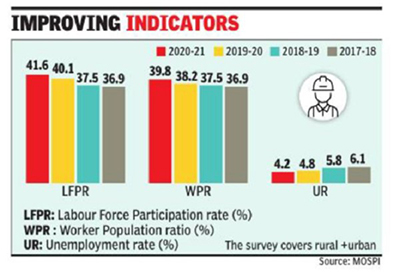Relevance: GS 3: Indian Economy and issues relating to planning, mobilisation of resources, growth, development and employment.
Key Phrases: Periodic Labour Force Survey (PLFS), National Statistical Office (NSO), Unemployment Rate, Labour Force, Ministry of Statistics and Programme Implementation, Worker Population Ratio.
Why in News?
- Recently, Ministry of Statistics and Programme Implementation, Government of India released the Annual Report of the Periodic Labour Force Survey (PLFS) for the reference period July 2020 to June 2021.
- This is the fourth report in the PLFS data series and offers information on both employment and unemployment for rural as well as urban areas.
What is the Periodic Labour Force Survey (PLFS)?
- The National Statistical Office (NSO) launched the Periodic Labour Force Survey (PLFS) in April 2017.
- The objective of PLFS is primarily two fold:
- to estimate the key employment and unemployment indicators (viz. Worker Population Ratio, Labour Force Participation Rate, Unemployment Rate) in the short time interval of three months for the urban areas only in the ‘Current Weekly Status’ (CWS); and
- to estimate employment and unemployment indicators in both ‘Usual Principal Status and Subsidiary Status (PS+SS)and CWS in both rural and urban areas annually.
Understanding key Employment and Unemployment indicators:
- Labour Force Participation Rate (LFPR): LFPR is defined as the percentage of persons in labour force (i.e., working or seeking or available for work) in the population.
- Worker Population Ratio (WPR): WPR is defined as the percentage of employed persons in the population.
- Unemployment Rate (UR): UR is defined as the percentage of persons unemployed among the persons in the labour force.
- Activity Status- Usual Status:
- The activity status of a person is determined on the basis of the activities pursued by the person during the specified reference period.
- When the activity status is determined on the basis of the reference period of last 365 days preceding the date of survey, it is known as the usual activity status of the person.
- Activity Status- Current Weekly Status (CWS):
- The activity status determined on the basis of a reference period of last 7 days preceding the date of survey is known as the current weekly status (CWS) of the person.
- Under CWS, a person is considered unemployed if he/she did not work even for one hour on any day during the week but sought or was available for work at least for one hour on any day during the period.
- Principal activity status: The activity status on which a person spent relatively long time (major time criterion) during 365 days preceding the date of survey, was considered the usual principal activity status of the person.
- Subsidiary economic activity status:
- The activity status in which a person in addition to his/her usual principal status, performs some economic activity for 30 days or more for the reference period of 365 days preceding the date of survey, was considered the subsidiary economic status of the person.
Key findings of the report:
- Rise in the number of workers:
- Preliminary analysis from the 2020-21 round survey indicates a rise in the number of workers in the Indian economy, with 539.5 million, as against 513.3 million in 2019-20. Of this increase of 26.2 million, male workers rose by 10.8 million while female workers increased by 15.3 million.
- All-India female Labour Force Participation Rate (LFPR) in usual status has increased from 2.3% in 2021 to 25.1% as compared to 22.8% a year ago.
- Declining unemployment rate:
- The increased count of workers was accompanied by a decline in the overall unemployment rate, with joblessness found to have fallen for every group, be it rural or urban or male or female, as well.


Can the data be misleading?
- The estimates suggest a sharp recovery in employment creation in our economy, with an accompanying decline in unemployment.
- But such interpretation could be misleading as:
- The economy suffers a sharp slowdown after 2016-17, with growth slumping from 8.3% that fiscal year to 3.7% in 2019-20,
- The two years after 2019-20 have been years of disruption in economic activity due to the pandemic, with our economy yet to fully recover from it.
- The per capita income of Indians was lower in 2021-22 than in 2018-19.
- Data on rural wages from India’s labour bureau also shows a decline in real wages of casual workers during the same period.
Has this anomaly happened earlier?
- An increase in employment during periods of distress in an economy like India is a known feature.
- This happened between 1999-2000 and 2004-05, when the number of workers increased by 60 million even though this was clearly a period of extreme distress.
Possible reasons for rise in the number of workers:
- Declining household income:
- Households that suffer a decline in income generally tend to increase their earnings by pushing the surplus labour available with them for example sharp increase in female employment.
- This is also true of the younger age group and elderly, as seen in the rise in work participation among these groups.
- Increasing agricultural labourers:
- It is due the reversal of a trend of the economy’s structural transformation involving the movement of workers away from agriculture.
- The Indian economy had witnessed a structural shift that accelerated in the mid-2000s, with the absolute number of workers in farming found to have declined by 66 million between 2004-05 and 2017-18.
- This confirms a distress-induced increase in employment witnessed in India.
- Growth in informal sector:
- The natural choice for unemployed is to get into the labour force at whatever cost which is more of a survival strategy than a natural increase in gainful employment as most of such employment is informal. The wages in 2020-21 are lower in real terms compared to 2017-18 in every quarter, confirming the decline in real wages of casual workers.
- Recent data confirms this trend, with the proportion of India’s working population employed in the informal non-farm sector having increased steadily from 68.2% in 2017-18 to 71.4% in 2020-21.
Unwanted outcomes of rise in Employment rate:
- Informalisation of the workforce:
- Along with that increase in the country’s count of workers in agriculture, which is entirely informal, recent estimates suggest a process of informalisation of the workforce, as against the claim of increasing formalisation based on worker registration.
- Poor work conditions:
- While the share of regular workers who generally enjoy a better quality of employment has seen a decline during this period, they have also seen deterioration in work conditions.
- No social security:
- The percentage of regular workers who do not get any social security benefit increased from 49.6% in 2017-18 to 53.8% in 2020-21. .
Suggestions for Employment Generation:
- Reform of factor markets:
- Reforms in land markets will increase supplies of land, and labour reforms that make employment contract more flexible will make businesses more willing to hire workers.
- Devolve more power to States, cities, and district- and village-level local
bodies:
- For higher economic activity, right macroeconomic conditions should be created at the State and district levels
- Rebalance tax policies:
- Tax policies must remove the tilt against wage incomes as opposed to incomes generated from capital.
- This will inevitably make overuse of capital and automation less attractive in a labour-surplus economy without necessarily impacting the use of more technology to improve productivity.
- Building amore agile education and skilling ecosystem:
- Policies are required for new skilling and educational institutions that are able to capture skill-demand trends and quickly translate this into courses and certifications that are useful to job seekers and employers.
- Universal (or even targeted) income support systems:
- The direct benefits transfer scheme be extended to almost all subsidies by making them cash-based.
- This will create genuine new markets for food, fertilizer, and fuel among other things, and also free labour to be more mobile.
- Focus on sectors with maximum employment elasticity:
- Sectors like construction, real estate, logistics, transport, apparel and leather products, furniture, education, and healthcare –apart from app-based services –must be given maximum support with minimum regulatory friction to generate jobs.
- Scale up the apprentices’ scheme and legislate fixed period job contracts:
- If we raise apprenticeship opportunities about twenty-fold, half our skilling and jobs problems will be over.
- Moreover, if the employers are enabled, by supportive legislation, to offer fixed-term contracts along with portable social security benefits, suddenly the bias towards capital intensive investment will start reducing.
Conclusion:
- Reversing the present employment trends would require an enabling policy framework to enhance employment quality as well as an economic revival that creates gainful and decent jobs for new entrants to the country’s workforce and for those who are engaged in the informal sector.
Source: Live-Mint
Mains Question:
Q. The Annual Report of the Periodic Labour Force Survey (PLFS) for the reference period July 2020 to June 2021 do not present the exact picture of unemployment in the country. Elaborate.







